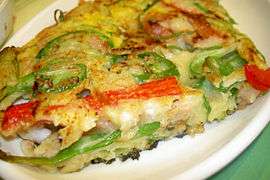Onion cake
Onion cake is a savory or sweet cake prepared using onion as a primary ingredient. Various onion cakes are consumed in China, Germany, Korea, Switzerland, Wales and in other countries. Several types and varieties of onion cakes exist, including laobing, pajeon, the scallion pancake, teisen nionod and zwiebelkuchen.
Sugar onion cakes | |
| Type | Savoury or sweet cake |
|---|---|
| Associated national cuisine | China, Germany, Korea, Switzerland, Wales |
| Main ingredients | Onion |
| Ingredients generally used | Other cake ingredients |
| Variations | Laobing, pajeon, the scallion pancake, teisen nionod and zwiebelkuchen |
Overview
Onion cake is prepared using onion as a main ingredient along with other typical cake ingredients.[1][2][3] The use of boiled onion can reduce the sharpness of the onion's flavor in onion cake.[3] Potato or bacon may also be used as a main ingredient in onion cake.[4][5][6][7] Additional ingredients can include cottage cheese[7] and sour cream.[8] Chocolate cake may be prepared using onion.[1] Various onion cakes are consumed in China, Germany, Switzerland, Wales and in other countries.[3][5][9][10][11]
In Chinese cuisine, onion cake may be prepared using spring onion,[12] (also referred to as scallion). A basic Chinese onion cake can consist of flour, lard, spring onion and salt.[12]
Varieties
Laobing
Laobing is a pancake or unleavened flatbread in Chinese cuisine that is prepared with flour, water and salt.[13][14][15] Scallions may be used as an additional primary ingredient, and scallions are sometimes served as a side dish with laobing.[16]
Pajeon
Pajeon is a savory jeon (pancake) dish in Korean cuisine prepared with a batter of flour, eggs and green onions or leeks.[17][18] Rice flour may also be used, along with additional ingredients, such as seafood,[19] pork and beef. Dongnae pajeon is prepared using green onion and seafood.[20]
 Haemul pajeon is a variety of pajeon in Korean cuisine made with flour, scallion and seafood
Haemul pajeon is a variety of pajeon in Korean cuisine made with flour, scallion and seafood
Scallion pancake
A scallion pancake is a Chinese pancake or unleavened flatbread prepared using scallion as a primary ingredient.[21] It is typically prepared using a dough, although some are prepared from a batter.[21] The scallion pancake is a traditional food in Shanghai, China, and is a common dish throughout the country.[21] In China, fresh scallions are typically used in the dish's preparation.[21] The scallion may be fried before it is added to the dough.[21]
Teisen nionod
Teisen nionod is a Welsh onion cake prepared with onion, potato, butter, beef stock, salt and pepper.[10][22]
Zwiebelkuchen
Zwiebelkuchen is a German onion cake or pastry prepared with steamed onion, bacon, cream and caraway seeds on leavened or yeast dough.[23][24]
See also
References
- Griffith, L.; Griffith, F. (2002). Onions, Onions, Onions: Delicious Recipes for the World's Favorite Secret Ingredient. Houghton Mifflin Harcourt. pp. 122–123. ISBN 978-0-547-34638-0.
- Baking Industry. Clissold Publishing Company. 1922. p. 486.
- Rainey, S.; Wilson, B. (2015). How to Jug a Hare: The Telegraph Book of the Kitchen. Aurum Press. p. 272. ISBN 978-1-78131-466-1.
- Hollywood, P. (2014). Paul Hollywood's British Baking. Bloomsbury Publishing. p. 352. ISBN 978-1-4088-4649-0.
- MacGregor, C. (2014). Everybody Loves Bacon. Familius. p. pt61. ISBN 978-1-939629-44-9.
- Hood, K.J.M. (2015). Onion Delights Cookbook: A Collection of Onion Recipes. Cookbook Delights Series. Whispering Pine Press International, Incorporated. ISBN 978-1-59210-426-0.
- Beck, K.; Clark, J. (2009). The All-American Cowboy Cookbook: Over 300 Recipes From the World's Greatest Cowboys. Thomas Nelson. pp. 255–256. ISBN 978-1-4185-7473-4.
- Prudhomme, P. (2012). Chef Paul Prudhomme's Seasoned America. HarperCollins. p. 2. ISBN 978-0-06-204688-8.
- "Swiss review of world affairs". Volumes 21–24. 1971.
Normally about 40 tons of onions are sold on this single day, usually in attractively designed strings, wreaths and other more exotic shapes. There is also onion cake, onion soup and dancing in the streets. This year Bern's Onion Festival takes ...
- Freeman, B. (1996). First Catch Your Peacock: Her Classic Guide to Welsh Food. Y Lolfa. p. 161. ISBN 978-0-86243-315-4.
- Hanover Cook Book. Cooking in America Series. Applewood Books. 2008. p. 228. ISBN 978-1-4290-1110-5.
- Chinese Cookery Secrets. The Kegan Paul library of culinary history and cookery. Taylor & Francis. 2014. p. 135. ISBN 978-1-317-84620-8.
- Qarooni, J. (2012). Flat Bread Technology. Springer US. p. 86. ISBN 978-1-4613-1175-1.
- Ang, A. (2012). To the People, Food Is Heaven: Stories of Food and Life in a Changing China. Lyons Press. p. 116. ISBN 978-0-7627-9040-1.
- Mooney, E.W. (2008). Beijing. Not just a good food guide. Marshall Cavendish Editions. p. 52. ISBN 978-981-232-997-4.
- DeFrancis, J. (1993). In the Footsteps of Genghis Khan. Kolowalu book. University of Hawaii Press. p. 100. ISBN 978-0-8248-1493-9.
- Stone, M. (2014). Traditions of South Korean Cooking: Learning the Basic Techniques and Recipes of the South Korean Cuisine. Martha Stone. p. pt76.
- Lim, B.H.; Lim, B.S. (2014). Kimchi: Essential recipes of the Korean Kitchen. EBL-Schweitzer. Pavilion Books. p. 148. ISBN 978-1-910496-24-4.
- Robinson, M.; Zahorchak, J. (2009). Seoul. City Guide Series. Lonely Planet. p. 97. ISBN 978-1-74104-774-5.
- DuBois, J. (2004). Korea. Cultures of the world. Benchmark Books/Marshall Cavendish. p. 130. ISBN 978-0-7614-1786-6.
- Lo, E.Y.F.; Cushner, S. (2012). Mastering the Art of Chinese Cooking. Chronicle Books LLC. p. 171. ISBN 978-0-8118-7870-8.
- Spencer, C. (2002). British Food: An Extraordinary Thousand Years of History. Arts and Traditions of the Table: Perspectives on Culinary History Series. Columbia University Press. p. 205. ISBN 978-0-231-13110-0.
- Shockey, K.K.; Shockey, C. (2014). Fermented Vegetables: Creative Recipes for Fermenting 64 Vegetables & Herbs in Krauts, Kimchis, Brined Pickles, Chutneys, Relishes & Pastes. Storey Publishing, LLC. p. 344. ISBN 978-1-61212-426-1.
- Buse, D.K. (2005). The Regions of Germany: A Reference Guide to History and Culture. Greenwood Press. p. 15. ISBN 978-0-313-32400-0.
.jpg)